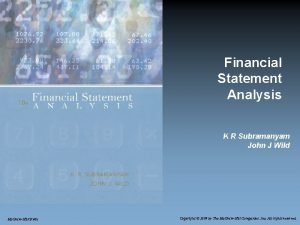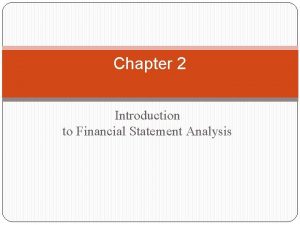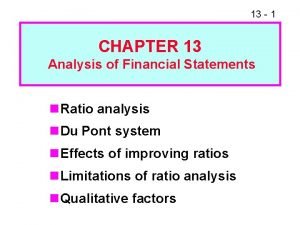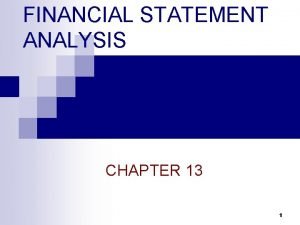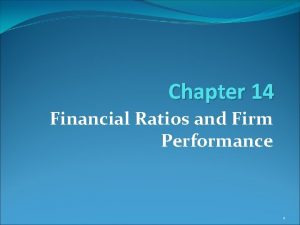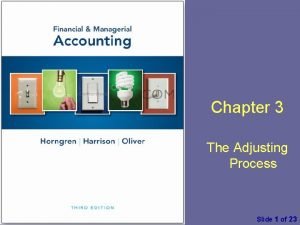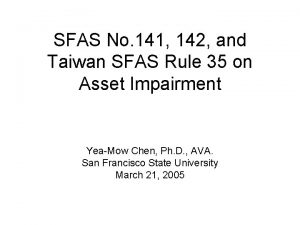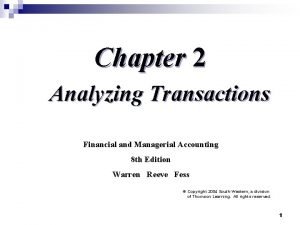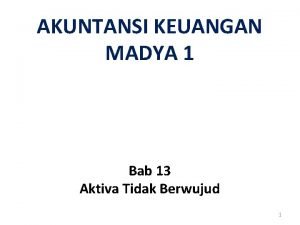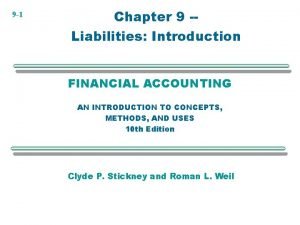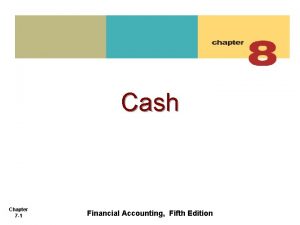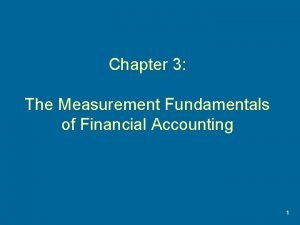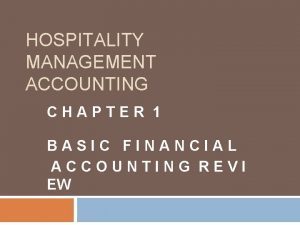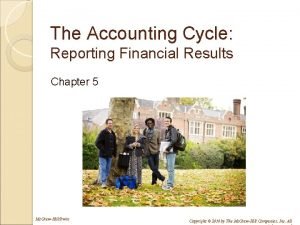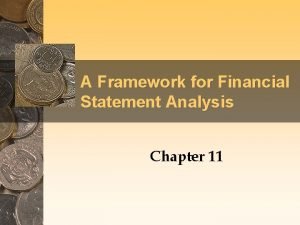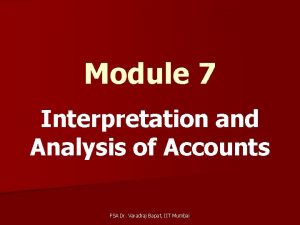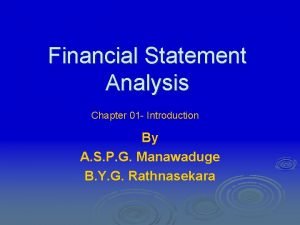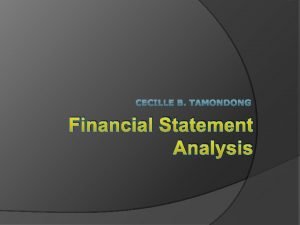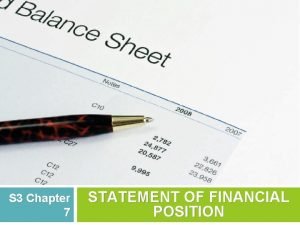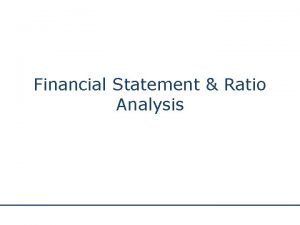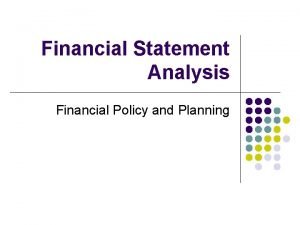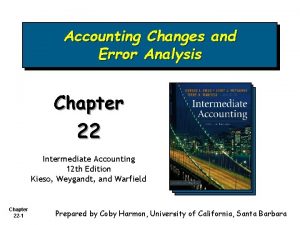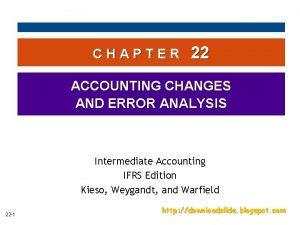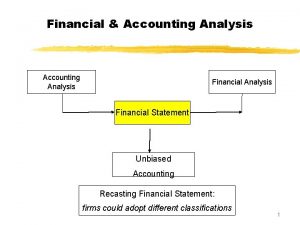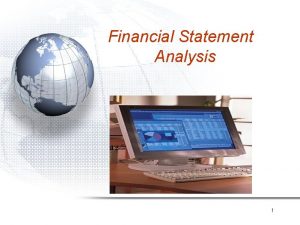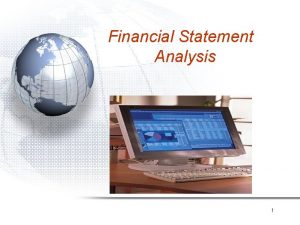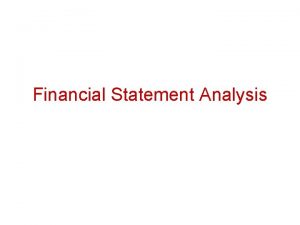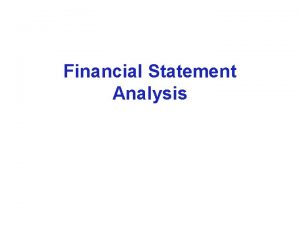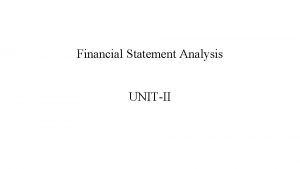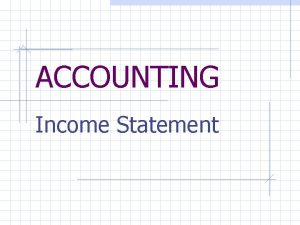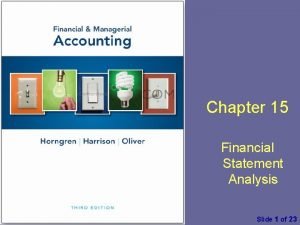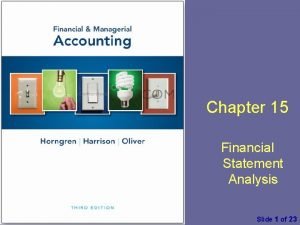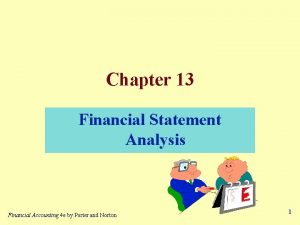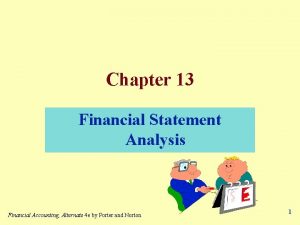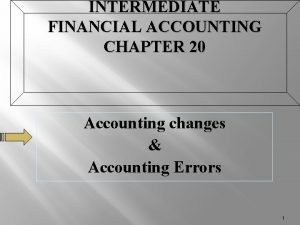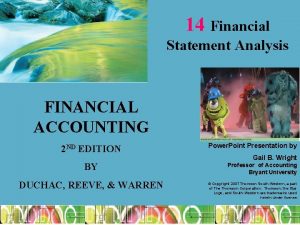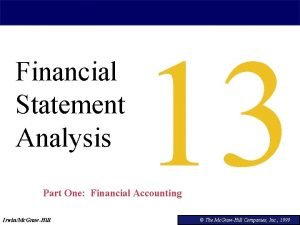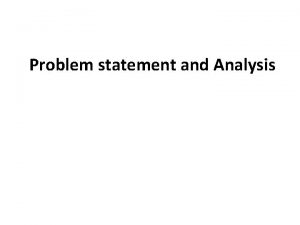Chapter 13 Financial Statement Analysis Financial Accounting The









































- Slides: 41

Chapter 13 Financial Statement Analysis Financial Accounting: The Impact on Decision Making 6 th by Gary A. Porter and Curtis L. Norton Copyright © 2009 South-Western, a part of Cengage Learning.

Financial Statement Analysis Creditors How good is our investment? Stockholders Will I be paid? How are we performing? Management

Limitations of Financial Statement Analysis v Use of different accounting methods LIFO FIFO v Changes in accounting methods LO 1

Limitations of Financial Statement Analysis ? ? v Failure to recognize trends in ratios v Difficulty of making industry comparisons (i. e. , conglomerates)

Limitations of Financial Statement Analysis v Nonoperating items on income statement v Effects of inflation Apples = Oranges

Horizontal Analysis v A comparison of financial statement items over a period of time v Read right to left to compare one year’s results with the next as a dollar amount of change and as a percentage of change from year to year $ % LO 2

Horizontal Analysis December 31 2008 2007 Cash Accounts receivable Inventory Prepaid insurance Total current assets $ 320 $1, 350 5, 500 4, 750 2, 750 150 200 $10, 720 $8, 800 Dollar change from year to year Increase (Decrease) Dollars Percent $(1, 030) 1, 000 2, 000 (50) $ 1, 920 (76)% 22 73 (25) 22 Percentage change from one year to the next year

Trend Analysis Wm. Wrigley Jr. Company Return on Average Equity 2006 2005 2004 2003 23% 23. 5% 24. 7% 26. 7% Tracking items over a series of years

Vertical Analysis v Common-size statements recast items as a percentage of a selected item % v Allows comparisons of companies of different size % v Compares percentages across years to identify trends % LO 3

Vertical Analysis December 31, 2008 December 31, 2007 Dollars Percent Cash Accounts receivable Inventory Prepaid insurance Total current assets $ 320 5, 500 4, 750 150 $10, 720 1. 9% $ 1, 350 32. 6 4, 500 28. 1 2, 750 0. 9 200 63. 5% $8, 800 Compare percentages across years to spot year-to-year trends 9. 8% 32. 6 19. 9 1. 5 63. 8%

Liquidity Analysis v Nearness to cash v Ability to pay debts as they become due LO 4

Working Capital v Excess of current assets over current liabilities v Lacks meaningful comparisons for companies of different size –

Current Ratio v Measure of short-term financial health v Consider composition of current assets Rule of thumb 2: 1

Acid-Test (Quick) Ratio v Stricter test of ability to pay debts v Excludes inventories and prepaid assets Quick Assets Current Liabilities

Cash Flow from Operations to Current Liabilities v Focuses on cash only v Can be used to indicate the flow of cash during the year to cover the debts due Net Cash Provided by Operating Activities Average Current Liabilities

Accounts Receivable Turnover Ratio Net Credit Sales Average Accounts Receivable Indicates how quickly a company is collecting (i. e. , turning over) its receivables

Number of Days’ Sales in Receivables Number of Days in the Period Accounts Receivable Turnover Represents the average number of days an account is outstanding

Number of Days’ Sales in Receivables Example: 360 days 4. 8 times = 75 days If this company’s credit terms are net 30, what would this tell you about the efficiency of the collection process?

Inventory Turnover Ratio Cost of Goods Sold Average Inventory Represents the number of times period inventory is turned over (i. e. , sold).

Number of Days’ Sales in Inventory Number of Days in the Period Inventory Turnover Represents the average number of days inventory is on hand before it’s sold

Cash Operating Cycle v Time between the purchase of merchandise and the collection of the from the sale Number of Days’ Sales in Inventory + Number of Days’ Sales in Receivables Purchase of Inventory Collection of Accounts Receivable

Solvency Analysis v Ability to stay in business over the longterm Debt-to. Equity Ratio Times Interest Earned Debt Service Coverage Cash Flow from Operations to Capital Expenditures LO 5

Debt-to-Equity Ratio Total Liabilities Total Stockholders’ Equity How much have creditors contributed compared to owners?

Debt-to-Equity Ratio For every dollar contributed by owners, creditors have loaned $. 89 Total Liabilities Total Stockholders’ Equity =. 89

Times Interest Earned v Measures ability to meet current interest payments v The greater the coverage the better Net Income + Interest Expense + Income Tax Expense Interest Expense

Debt Service Coverage v Measures amount of cash from operating activities available to “service” the debt Cash Flow from Operations Before Interest and Tax Payments Interest and Principal Payments

Cash Flow from Operations to Capital Expenditures Ratio v Measures company’s ability to use operations (vs. creditors and owners) to finance its acquisitions of productive assets Cash Flow from Operations – Total Dividends Paid Cash Paid for Acquisitions

Profitability Analysis v Rate of Return on Assets v Return on Common Stockholders’ Equity v Earnings per Share v Price/Earnings Ratio v Dividend Ratios LO 6

Return on Assets Ratio v Measures return to all providers of capital (creditors and owners) Net Income + Interest Expense, Net of Tax Average Total Assets

Return on Common Stockholders’ Equity Net Income – Preferred Dividends Average Common Stockholders’ Equity The owners earned 15% on their investment in ABC Co. . . Not bad!

Earnings per Share v Presents profits on a per-share basis Net Income – Preferred Dividends Weighted Average Number of Common Shares Outstanding

Price/Earnings Ratio v Relates earnings to the market price of stock the Current Market Price Earnings per Share very high P/E very low P/E possibly overpriced possibly underpriced

Price/Earnings Ratio P/E Ratios Co. A Co. B = 9 to 1 = 8 to 1 Both companies have earnings of $2 per share. So why the different P/E ratios?

Dividend Payout Ratio Common Dividends per Share Earnings per Share We need to decide what percentage of the firm’s income we can return to owners

Dividend Yield Ratio v Investors willing to forgo dividends in lieu of price appreciation Common Dividends per Share Market Price per Share = usually < 5%

Appendix Accounting Tools: Reporting and Analyzing Other Income Statement Items

Common Characteristics v All such items are reported after income from continuing operations v Reported separately v Shown net of tax effects v Most analysts ignore these items, since they are not likely to reoccur LO 7

Discontinued Operations v Any gain or loss from disposal of a division or segment of the business v Any net income or loss from operating this portion until the date of disposal

Extraordinary Items Gain or loss due to an event that is v Unusual in nature AND v Infrequent in occurrence

Cumulative Effect of a Change in Accounting Principle v Reflects a change in a company’s accounting principles, practices, or methods v Reports the difference in income in all prior years between the old method and the new method v Sometimes such a change is dictated by a new accounting standard

End of Chapter 13
 Financial accounting and accounting standards chapter 1
Financial accounting and accounting standards chapter 1 Social responsibility accounting ppt
Social responsibility accounting ppt Summary of ratio analysis
Summary of ratio analysis Financial statement analysis subramanyam
Financial statement analysis subramanyam Chapter 14 financial statement analysis solutions
Chapter 14 financial statement analysis solutions Financial statement analysis chapter 2 solutions
Financial statement analysis chapter 2 solutions Chapter 13 financial statement analysis
Chapter 13 financial statement analysis Analysis of financial statements
Analysis of financial statements Chapter 1 overview of financial statement analysis
Chapter 1 overview of financial statement analysis Chapter 14 financial statement analysis
Chapter 14 financial statement analysis Current cash debt coverage ratio
Current cash debt coverage ratio Income statement in financial accounting
Income statement in financial accounting Sfas no 142
Sfas no 142 Financial accounting chapter 2 solutions
Financial accounting chapter 2 solutions Financial accounting chapter 13
Financial accounting chapter 13 Financial accounting chapter 6
Financial accounting chapter 6 Financial accounting chapter 9
Financial accounting chapter 9 Financial accounting chapter 7
Financial accounting chapter 7 Financial accounting ifrs 4th edition chapter 12
Financial accounting ifrs 4th edition chapter 12 Financial accounting chapter 3
Financial accounting chapter 3 Accounting in action
Accounting in action Accounting for hospitality managers
Accounting for hospitality managers Financial accounting chapter 5
Financial accounting chapter 5 Framework for financial analysis
Framework for financial analysis Objectives of financial statement analysis
Objectives of financial statement analysis Horizontal analysis interpretation
Horizontal analysis interpretation Introduction of financial statement analysis
Introduction of financial statement analysis Financial statement of commercial bank
Financial statement of commercial bank What is vertical financial statement analysis
What is vertical financial statement analysis Internal users of financial reports
Internal users of financial reports Limitations of financial statement analysis
Limitations of financial statement analysis Financial statement analysis and planning
Financial statement analysis and planning Chapter 22 accounting changes and error analysis
Chapter 22 accounting changes and error analysis Chapter 22 accounting changes and error analysis
Chapter 22 accounting changes and error analysis Hát kết hợp bộ gõ cơ thể
Hát kết hợp bộ gõ cơ thể Bổ thể
Bổ thể Tỉ lệ cơ thể trẻ em
Tỉ lệ cơ thể trẻ em Voi kéo gỗ như thế nào
Voi kéo gỗ như thế nào Chụp phim tư thế worms-breton
Chụp phim tư thế worms-breton Bài hát chúa yêu trần thế alleluia
Bài hát chúa yêu trần thế alleluia Các môn thể thao bắt đầu bằng tiếng nhảy
Các môn thể thao bắt đầu bằng tiếng nhảy



